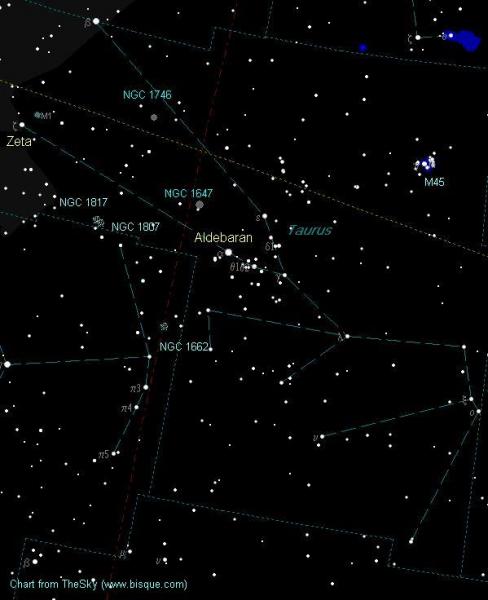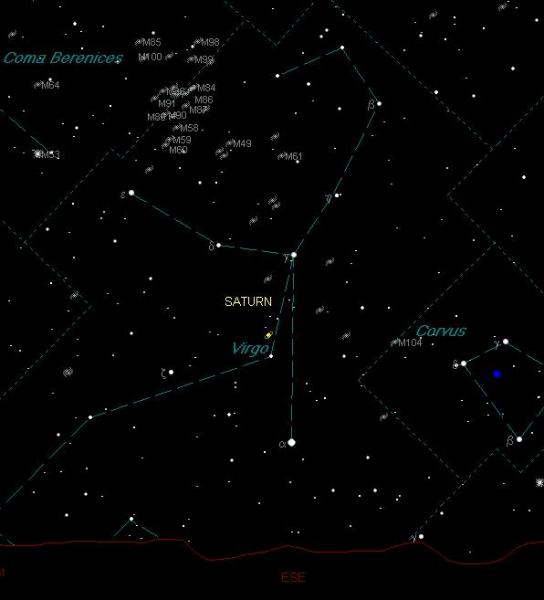Taurus The Bull
Of the 88 constellations that divide our dear skies, 40 portray the starry outline of animals. Some appear warm and cuddly like Lepus the Hare or the majestic winged horse Pegasus while others seemed wild and ferocious like Ursa Majoris. At this time of year, none is more dangerous than Taurus the Bull. With its prominent V-shaped horns, thanks to the Hyades cluster located 150 light-years from us, mythology paints the picture of the bull taking on Orion the Hunter in battle. The entire cluster spans some five degrees across with the prominent first magnitude star named Aldebaran.
This 65 light-year orangey coloured giant star has consumed its hydrogen supply fuel and is currently fusing helium into carbon to live. Although Aldebaran seems quite at home nestled in the Hyades cluster, it is actually a foreground star that is only 60 light-years from us and it is not part of the cluster what so ever. Starving for fuel, Aldebaran has expanded to a radius of 40 solar masses or it would span halfway out to the planet Mercury if it were our daytime star. This would not be a good thing for us.
There are a couple of naked-eye open clusters located within the long horns of the beast. First on the list is NGC 1647 which is only three and a half degrees east of Aldebaran. At magnitude 6.4 this round scattered group takes up the area of the full moon and is best viewed in low power telescopes. Once you lock on it, about 60 suns will reveal themselves.

Move your scope another six degrees in the same easterly direction till you come across NGC 1746. Only a dozen loosely scattered stars are visible. Still a nice cluster to check off your list. Both clusters and Aldebaran lie up quite nicely. NGC 1817 and NGC 1807 form a close pair of open clusters. They shine at magnitudes 7.7 and 7.0 respectively and of the two, NGC 1817 does have some bright stars but harbours many fainter 12th and 13th magnitude suns. NGC 1807, on the other hand, is populated by only a few members.
The first object catalogued to the Messier list of objects is of course M1. While searching for comets, Charles rediscovered the cloudy object in 1758. This celestial smudge was first observed by John Bevis some 27 years earlier. There are 110 Messier objects and is a great way to begin your telescope observations. Commonly known as the Crab Nebula, M1 is the remnants of a star that went supernova in the year 1054 AD. In fact, the target star outshone the moon for 23 nights. It is now magnitude 8.4 and a bit of a challenge from suburban skies. The leftover pulsar is about 30 kilometres wide but spinning at an astonishing rate of 30 times per second. The Crab is about a degree northwest of Zeta Tauri and is 6,300 light-years from us.

Another popular star cluster that portrays the heart of the bull in mythology is the Pleiades cluster or M45. Also named the Seven Sisters, M45 is a popular target for astrophotographers either by itself or with close proximity to the waxing or waning crescent moon. This collection of suns is thought to be 440 light-years away and is so wide, two full moons side by side will cover it. Visual confirmation of all seven stars without optical aid is a guideline to sky conditions and transparency.
Now that we have looked at the mighty bull, let's sneak a peek at little Aries the Ram. First of all, a total of three stars make up the asterism. The faintest of the trio named Mesarthim is a decent double star to observe. Visually recorded at magnitude 4.0, this system lies a little more than 200 light-years away and consisted of two fairly equal magnitude 4.8 white stars.
Aries does have a good selection of galaxies but they are mostly the round elliptical type without detail. There is however NGC 972 towards the upper section and close to the Triangulum border. At 69 million light-years from us, NGC 972 sports some arm structure that shows best in photos. It glows at magnitude 11.3 and is 3.6 arc minutes in length. While in the area and are up for a challenge. UGC 2116 lies only one and three-quarter degrees to the northeast of NGC 972. This target is a faint face-on galaxy listed at magnitude 15.3.
The planet Jupiter is slowly sinking into the west and sets by 10:30 local time. This means our distance is increasing as well and will be on the other side of the Sun on April 6th. On January 5th the planet Uranus and Jupiter can be seen in a low powered eyepiece. Both are separated by 32 are minutes or the width of the full moon. On the night of January 17th, train your telescope on Jupiter to witness a couple of satellites and then shadow transits across its disk. Another double transit show is listed on the night of January 25th as well. Refer to page 240 of the 2011 Observer's Handbook of the RASC.
Venus is located in Libra and lights up the morning sky at 5 a.m. local time before sunrise. Its greatest elongation (meaning farthest from the Sun) will occur on January 8th when it will be 47 degrees from our daytime star. In a telescope, Venus looks like a capital D but as the weeks move on, it will appear to sink closer to the horizon with its disk shrink as our distance increases. Because the Sun’s angle will be greater, its face changes from the capital D to a gibbous (egg shape) phase. The next morning will see Mercury in the constellation Ophiuchus at its elongation of only 23 degrees from the Sun.
Saturn is slowly crawling up the sky and its great rings are opening up to ten degrees, a bit more from the last time we gazed and photographed it. In January it is up by 1 a.m. local time but the seeing will be terrible. Wait for it to rise a good thirty degrees from the horizon with less atmosphere distortion playing with its light.
The tilt of the rings are finally opening up to about 10 degrees as compared to last year's 4 degrees but more so check out the sizeable storm lurking in its northern hemisphere. Who knows how long it will last.
This month's full moon is the Wolf Moon and occurs on the 19th.
Until next month, clear skies everyone.

